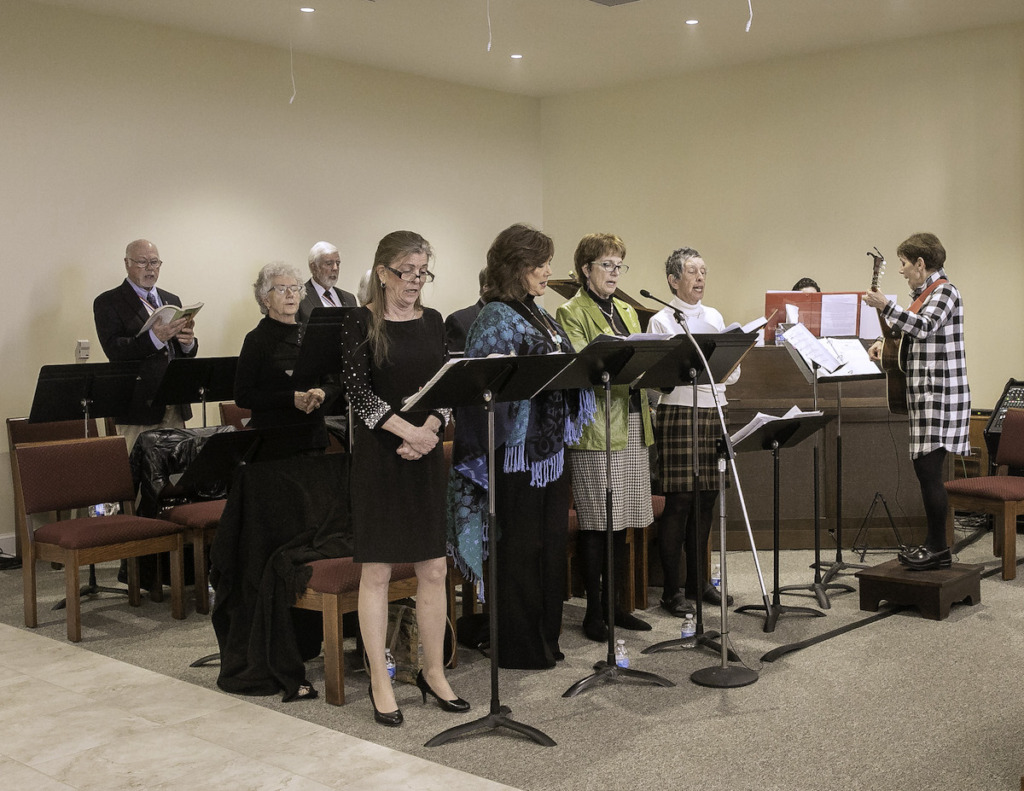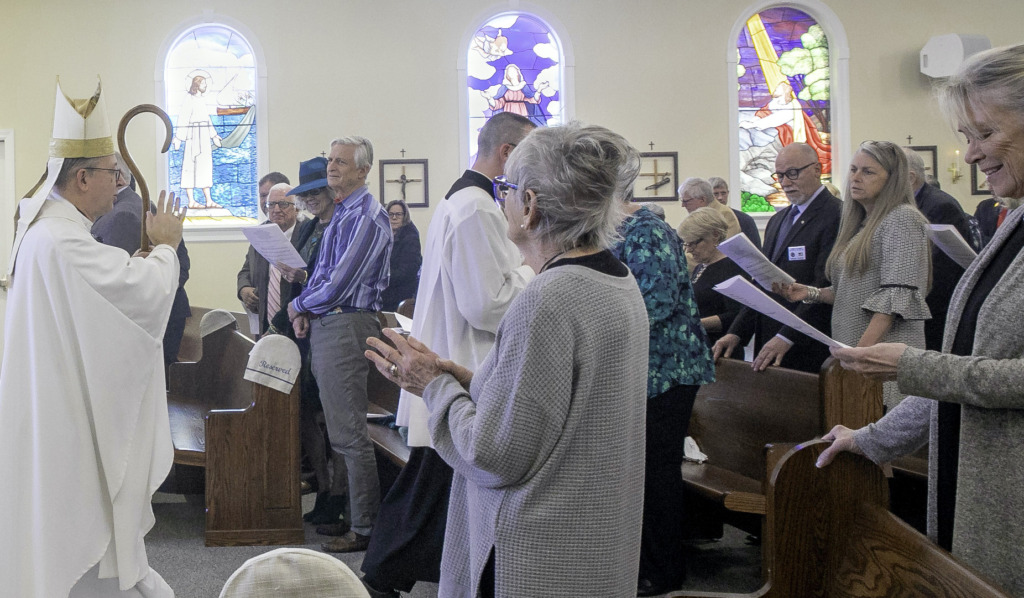Bishop dedicates addition at Topping parish
You might say that establishing Church of the Visitation (CV), Topping — at which Bishop Barry C. Knestout dedicated a new worship space Saturday, Feb. 26 — entailed a priest on a moped, an appeal to the bishop’s stomach and a lot of tenacity in the 1980s.
You could trace the history a bit further. In the late 1940s, a priest spread the Word in Middlesex County from a truck with a loudspeaker. In the 1950s and 1960s, a priest from Our Lady of the Blessed Sacrament, West Point, celebrated summer Masses in this rural area on the Middle Peninsula, which attracts seasonal visitors largely for its proximity to the Rappahannock River.
In the summer of 1980, Father Jack Dougher, a new assistant pastor of St. Therese Church, Gloucester, hopped on his moped and personally canvassed people he thought might be Catholic in the county to determine the feasibility of starting a Catholic church there. At the time, Catholics living in the 211-square-mile county had to drive to Tappahannock, West Point, Gloucester or Kilmarnock for Mass.
“It was very exciting. We were a small group that spun off,” said Joe Oliva, one of the first CV parishioners. “Starting out, Father Jack Dougher was the pastor. He was a very charismatic guy, and he brought people together. There was a real enthusiasm at that early stage to start something new, and there was a lot of work, a lot of meetings, a lot of discussions.”
Where two or more were gathered
The fledgling parish worshipped at Zoar Baptist Church in Deltaville, Lower Methodist Church in Hartfield and Christchurch School Chapel in Christchurch for the first year. It began renting Freeshade Community Center, Syringa, in October 1981 for Sunday Masses.
There were about 50 year-round people (20 families) at the time, but attendance doubled in the summer months due to tourism. Most committee meetings and social gatherings were scheduled for Sunday as well because the Middlesex Catholic Community was allowed to use Freeshade for the entire day.
Masses for holy days were celebrated at other churches or in parishioners’ homes. Mary Ellen Sherwood, who served on the steering committee for the new parish, fondly remembers a baptism in a park and another in a parishioner’s backyard, and she recalls the “honky-tonk-sounding piano” that plinked out the hymns at Freeshade.
When Bishop Walter F. Sullivan went to Middlesex on Feb. 6, 1982, to discuss plans for a new church, they met at a parishioner’s home where they served oyster stew, a favorite of his. He gave the nod for the Middlesex Catholic Community to be a mission of St. Therese Church and officially designated the parish Church of the Visitation in July 1983. It now has 135 households, which amounts to approximately 300 parishioners.
Father Gerald Kaggwa, the pastor and a native of Uganda, said most people moving to Middlesex are retirees, so a challenge for the parish is to attract younger parishioners. The county itself had only 10,625 residents in the 2020 census, approximately 32% of whom were 65 or older, according to the U.S. Census Bureau website.
Space solely for worship
CV’s first church was a multipurpose building when it was dedicated in September 1985. The worship space was also used for social events and had a kitchen and bathrooms. An education wing was added in 1991.
In September 2008, the nave was expanded, and a daily Mass chapel, administration wing and additional bathrooms were added. The new space seats 283 and is the first space dedicated solely to worship.
The parish used an existing building fund and raised $500,000 through a capital campaign and a memorial donations campaign to pay for the project. It also has a 15-year, $185,000 loan, said Ray Kostesky, church administrator.
“To me, it’s an amazing accomplishment for a mission church to complete two major construction projects with no help from anybody other than our own parishioners,” Kostesky said.
“It appears anytime you would ask our parishioners for a real, valid need, they respond beautifully,” Kostesky continued. “Even though we are a mission church, people dig down deeply for needy projects.”
‘Looks more as a church’
The $1.6 million addition includes a confessional and the installation of 14 stained glass windows, 11 of which are in the worship space. The new space also has new pews with kneelers and a baptismal font made by parishioner Tom Shoemaker. An ambo and altar made by parishioners Matthew and Ben Sherwood replaces the altar made by their father, Paul Sherwood, years ago. That one will be used to hold the tabernacle once used by the Little Sisters of the Poor in Richmond.
“The whole shape and structure — it looks more as a church,” said Father Kaggwa. “When you enter there, you know you are entering a church.”
Ground was broken on the nave Nov. 20, 2020, and the first Mass was celebrated Jan. 30, 2022.
Kostesky said he was overwhelmed with the beauty of the church.
“I just became tearful for a moment when I was looking at it, and I’m a 30-year Marine” he said.
In his homily, Bishop Knestout noted that the addition was “vital work of any parish, to provide an ongoing presence, sure footing, and stable foundation for families of faith to be formed, grow and mature.” He continued, “This worship space offers shelter, a beautiful environment, and a suited setting to assist us to follow Christ in his Paschal Mystery.”
Solemnity for the church
Having a separate worship area will make life easier now that the room doesn’t have to be rearranged for funerals and social events, but the addition also adds more solemnity to the church, parishioners said.
As parishioner Don Delagrange, building committee chair, explained, the existence of an entranceway in front of the new church sets a more sacred tone.
“When the multi-purpose room was used, people tended to talk with each other before the service, and they had to ring the bells to get everyone seated and quiet,” he said. “Now people socialize in the narthex outside the worship space and are quiet once in. It’s just a nice, quiet, solemn area that you go into, and it prepares you for church, prepares you for the service.”
Serena Beckett, organist, agreed that a separate worship space is important.
“It’s huge for me. I come from a very traditional background, and that’s my preference liturgically as well,” she said. “It creates a higher atmosphere of reverence that there’s just so much more potential for getting into the right space and frame of mind for praying and worshipping in the first place.”

Socializing in the old worship area had become such a norm that Shoemaker said he was surprised by the congregation’s “chatting” before the liturgy when he and his wife attended Mass there for the first time in 2005 while visiting the area. The next time they attended, it was announced that it was “Social Sunday,” meaning there would be a reception after the Mass. His wife, JoAn, leaned over and jokingly said, “I thought every Sunday was social Sunday.”
‘Generous hearts’
Parishioners described the parish as welcoming, friendly and like a family. That atmosphere is what prompted Don and Sandi Delgrange to convert to Catholicism after visiting the parish in 2015. At the beginning of the Mass, they stood when first-time visitors were asked to do so, and after Mass several people introduced themselves.
“At that point in our lives, we had tried several different churches in the area to see where we wanted to join and belong,” Sandi said “After Mass, so many of the parishioners came up and welcomed us, introduced themselves, made us feel welcome. That was why we chose to join here. It feels like family at this church.”
Father Kaggwa also said the parishioners “love one another” and are “like family.”
“Being a small parish is special because you come to know people more and more, so you are involved in their lives and you know them almost on a personal level,” Father Kaggwa said. “They are very generous people in everything. They are generous in their hearts. They are very good. That’s where I can say it is special.”
Editor’s note: Parish history was taken from church website, parish materials and the Diocese of Richmond bicentennial book, “Shine Like Stars.”

